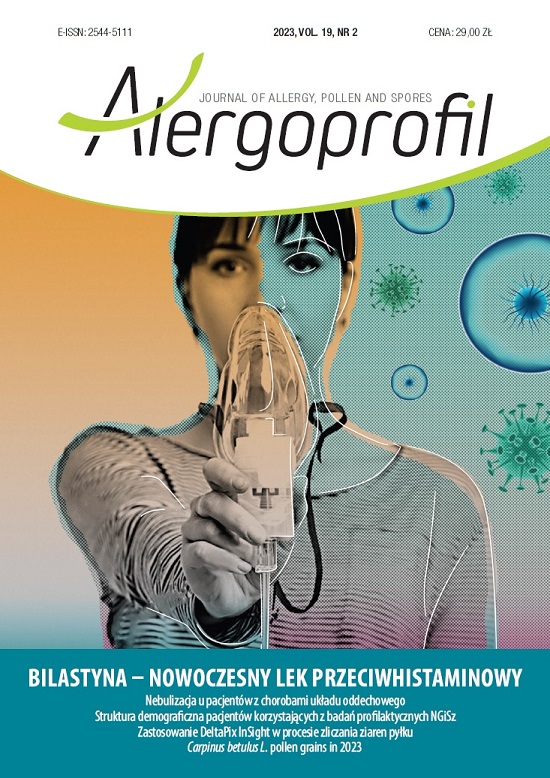Nebulization in patients with respiratory tract infections in the infectious season Review article
Main Article Content
Abstract
Respiratory tract infections are the most common problem in everyday practice of family doctors. The most of them are moderate, self-limited viral infections. Symptoms of the respiratory tract infections significantly affect the quality of patient’s lives. Regarding the treatment, conservative therapy is usually effective. Nebulization is recommended as an effective method supporting the therapy of acute respiratory tract infections. Nebulization is about to turn a liquid drug into a aerosol introduced directly to the patient’s bronchioles. There are a lot of different inhalers on the market. From the clinical point of view the most important matter is the size of the created particles. Different saline solutions have been commonly used in medicine since many years. Their main advantage is the change in the structure of the pathological mucus accumulating in the respiratory tract during the infection. For most of patients nebulization is safe and well tolerated.
Downloads
Article Details

This work is licensed under a Creative Commons Attribution-NonCommercial-NoDerivatives 4.0 International License.
Copyright: © Medical Education sp. z o.o. This is an Open Access article distributed under the terms of the Attribution-NonCommercial 4.0 International (CC BY-NC 4.0). License (https://creativecommons.org/licenses/by-nc/4.0/), allowing third parties to copy and redistribute the material in any medium or format and to remix, transform, and build upon the material, provided the original work is properly cited and states its license.
Address reprint requests to: Medical Education, Marcin Kuźma (marcin.kuzma@mededu.pl)
References
2. Lange J, Marczak H. Infekcje dróg oddechowych u dzieci. Medycyna Praktyczna online 2016 (access: 23.10.2022).
3. Emeryk A, Pirożyński M, Mazurek H et al. Polski przewodnik inhalacyjny. 2nd ed. Via Medica, Gdańsk 2021: 1-33.
4. Martin AR, Finlay WH. Nebulizers for drug delivery to the lungs. Expert Opin Drug Deliv. 2015; 12(6): 889-900.
5. Ari A. Jet, Ultrasonic, and Mesh Nebulizers: an evaluation of nebulizers for better clinical outcomes. Eurasian J Pulm. 2014; 16: 1-7.
6. Pirożyński M, Florkiewicz E, Sosnowski TR. Podstawy nebulizacji – rodzaje inhalatorów. In: Pirożyński M (ed). ABC nebulizacji ze szczególnym uwzględnieniem dawkowania. Via Medica, Gdańsk 2015: 27-42.
7. Emeryk A, Pirożyński M. Nebulizacja: czym, jak, dla kogo, kiedy? Polski Konsensus Nebulizacyjny. Medycyna Praktyczna – Pneumonologia. 2013; 1(wyd. spec.): 2-8.
8. Boe L, Dennis J, O’Driscoll BR et al. European Respiratory Society Task Force on the use of nebulizers. Eur Respir J. 2001; 18: 228-42.
9. Emeryk A, Emeryk-Maksymiuk J, Janeczek K et al. Hipertoniczne roztwory soli w terapii chorób dróg oddechowych. Alergoprofil. 2020; 16(3): 10-7.
10. King D, Mitchell B, Williams CP et al. Saline nasal irrigation for acute upper respiratory tract infections. Cochrane Database Syst Rev. 2015; 20(4): CD00681.
11. Orlandi RR, Kingdom TT, Hwang PH et al. International Consensus Statement on Allergy and Rhinology: Rhinosinusitis. Int Forum Allergy Rhinol. 2016; 6: 22-209.
12. Roberts G, Xatzipsalti M, Borrego LM et al. Paediatric rhinitis: position paper of the European Academy of Allergy and Clinical Immunology. Allergy. 2013; 68: 1102-16.
13. Li C-L, Lin H-C, Lin C-Y et al. Effectivness of Hypertonic Saline Nasal Irrigation for Alleviating Allergic Rhinitis in Children: A Systematic Review and Meta-Analysis. J Clin Med. 2019; 8: 64.
14. Köksal T, Çizmeci MN, Bozkaya D et al. Comparison between the use of saline and seawater for nasal obstruction in children under 2 years of age with acute upper respiratory infection. Turk J Med Sci. 2016; 46(4): 1004-13.
15. Balsamo R, Lanata L, Egan CG. Mucoactive drugs. Eur Respir Rev. 2010; 19: 127-33.
16. Rabago D, Zgierska A. Saline nasal irrigation for upper respiratory conditions. Am Fam Physician. 2009; 80(10): 1117-9.
17. Talbot AR, Herr TM, Parsons DS. Mucociliary clearance and buffered hypertonic saline solution. Laryngoscope. 1997; 107: 500-3.
18. Safdar A, Shelburne SA, Evans SE et al. Inhaled therapeutics for prevention and treatment of pneumonia. Expert Opin Drug Saf. 2009; 8(4): 435-49.
19. Wark P, McDonald VM. Nebulised hypertonic saline for cystic fibrosis. Cochrane Database Syst Rev. 2018; 9(9): CD001506.
20. Pasteur MC, Bilton D, Hill AT; Thoracic Society Bronchiectasis (non-CF) Guideline Group. British Thoracic Society guideline for non-CF bronchiectasis. Thorax. 2010; 65: 1-58.
21. Linssen RSN, Ma J, Bem RA et al. Rational use of mucoactive medications to treat pediatric airway disease. Paed Respir Rev. 2020; 36: 8-14.
22. 2021 GINA Report, Global Strategy for Asthma Management and Prevention (access: 2.08.2021).
23. GOLD 2021. 2021 Global strategy for prevention, diagnosis and management of COPD (access: 2.08.2021).

